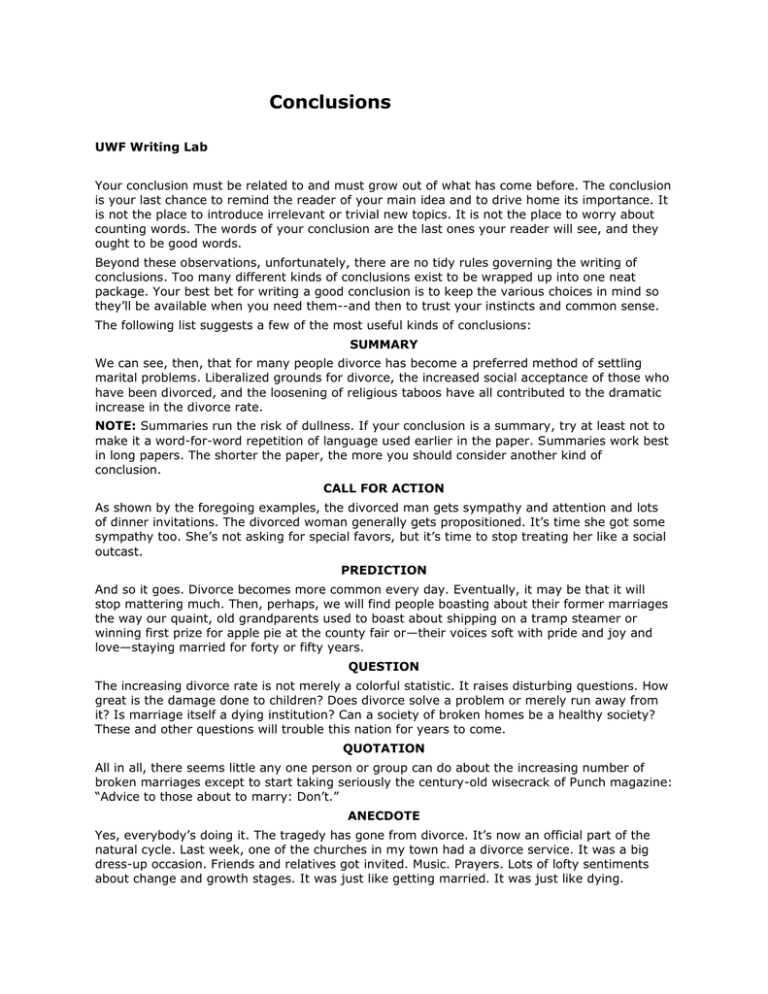Conclusions
advertisement

Conclusions UWF Writing Lab Your conclusion must be related to and must grow out of what has come before. The conclusion is your last chance to remind the reader of your main idea and to drive home its importance. It is not the place to introduce irrelevant or trivial new topics. It is not the place to worry about counting words. The words of your conclusion are the last ones your reader will see, and they ought to be good words. Beyond these observations, unfortunately, there are no tidy rules governing the writing of conclusions. Too many different kinds of conclusions exist to be wrapped up into one neat package. Your best bet for writing a good conclusion is to keep the various choices in mind so they’ll be available when you need them--and then to trust your instincts and common sense. The following list suggests a few of the most useful kinds of conclusions: SUMMARY We can see, then, that for many people divorce has become a preferred method of settling marital problems. Liberalized grounds for divorce, the increased social acceptance of those who have been divorced, and the loosening of religious taboos have all contributed to the dramatic increase in the divorce rate. NOTE: Summaries run the risk of dullness. If your conclusion is a summary, try at least not to make it a word-for-word repetition of language used earlier in the paper. Summaries work best in long papers. The shorter the paper, the more you should consider another kind of conclusion. CALL FOR ACTION As shown by the foregoing examples, the divorced man gets sympathy and attention and lots of dinner invitations. The divorced woman generally gets propositioned. It’s time she got some sympathy too. She’s not asking for special favors, but it’s time to stop treating her like a social outcast. PREDICTION And so it goes. Divorce becomes more common every day. Eventually, it may be that it will stop mattering much. Then, perhaps, we will find people boasting about their former marriages the way our quaint, old grandparents used to boast about shipping on a tramp steamer or winning first prize for apple pie at the county fair or—their voices soft with pride and joy and love—staying married for forty or fifty years. QUESTION The increasing divorce rate is not merely a colorful statistic. It raises disturbing questions. How great is the damage done to children? Does divorce solve a problem or merely run away from it? Is marriage itself a dying institution? Can a society of broken homes be a healthy society? These and other questions will trouble this nation for years to come. QUOTATION All in all, there seems little any one person or group can do about the increasing number of broken marriages except to start taking seriously the century-old wisecrack of Punch magazine: “Advice to those about to marry: Don’t.” ANECDOTE Yes, everybody’s doing it. The tragedy has gone from divorce. It’s now an official part of the natural cycle. Last week, one of the churches in my town had a divorce service. It was a big dress-up occasion. Friends and relatives got invited. Music. Prayers. Lots of lofty sentiments about change and growth stages. It was just like getting married. It was just like dying. RESTATING OF THE IMPORTANCE OF THE TOPIC At a time when news magazines and television specials go into weekly panic about gas mileage and electric bills, about the balance of payments and inflation, about disarmament and dictatorships, it may almost seem frivolous to start brooding about how many people are getting divorced. In an age of revolution, it may seem almost irresponsible to create a new panic by studying statistics at the county courthouse. In the long run, however, nothing may be less frivolous or more thoroughly revolutionary for American civilization than the frightening basic truths revealed by the divorce figures of our turbulent society.
